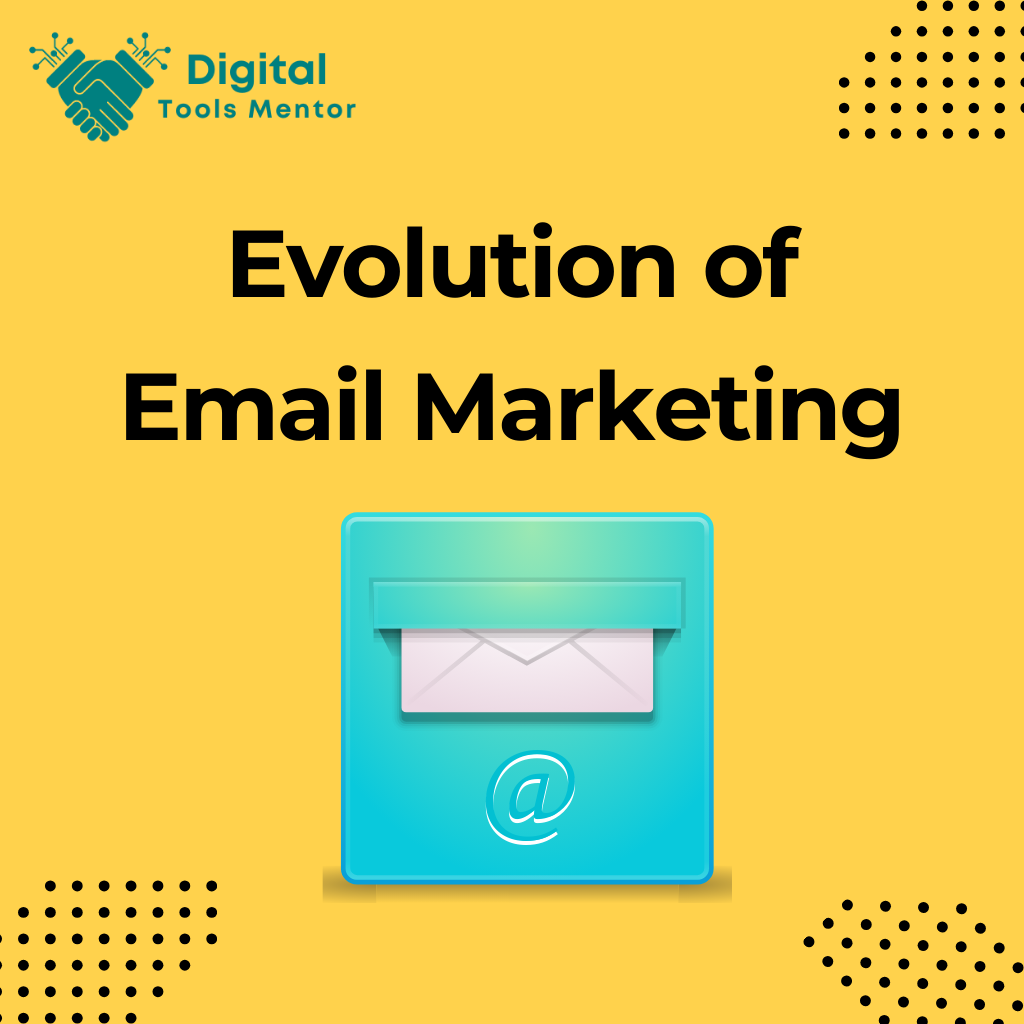From Mailboxes to Inboxes: The Evolution of Email Marketing
Email marketing, one of the oldest forms of digital communication, remains a cornerstone of effective marketing strategies even in today’s fast-paced digital landscape. Since its inception, the evolution of email marketing is, adapting to changes in technology, consumer behavior, and regulatory landscapes. Despite the rise of social media and other newer digital marketing channels, email marketing continues to offer unparalleled reach and ROI.
This enduring relevance is due in part to email’s direct and personal nature. It allows marketers to reach customers right in their inboxes, providing a level of direct engagement that other platforms struggle to match. Moreover, the flexibility and scalability of email marketing make it accessible for businesses of all sizes—from small startups to large corporations. It can be finely tailored to meet diverse marketing objectives, whether it’s building brand awareness, promoting new products, nurturing leads, or retaining customers.
In the digital era, email marketing has become even more crucial. It not only supports direct communication with customers but also integrates seamlessly with other digital marketing strategies, enhancing the effectiveness of advertising, content marketing, and customer relationship management systems. As we delve deeper into the history and evolution of email marketing, we’ll explore how this tool has grown from simple electronic messages to a sophisticated engine driving modern marketing strategies, continually adapting to new technologies and shifting consumer expectations.
The Beginnings of Email Marketing
The origins of email marketing can be traced back to the early days of the internet, when the first email was sent in 1971 by Ray Tomlinson. This simple act of sending a message from one computer to another laid the groundwork for what would eventually become a pivotal marketing tool. However, it wasn’t until the 1990s that email began to be seen as a potential marketing medium.
First Uses for Marketing: The first significant use of email for marketing purposes is often credited to a company called Digital Equipment Corp (DEC) in 1978. DEC used this new tool to send out a mass email to approximately 400 potential clients via the ARPANET, advertising their new line of computers. This campaign was remarkably successful, resulting in a significant spike in sales and demonstrating the potential of email marketing to reach a large audience quickly and at a relatively low cost.
Technological Advancements: Several key technological advancements were crucial in enabling the widespread use of email marketing:
- Development of the Internet: As the internet became more accessible to the public, particularly in the early 1990s, the number of email users grew exponentially. This broad audience base made email marketing an attractive option for businesses.
- HTML Email: The introduction of HTML email in the mid-1990s allowed marketers to create more visually appealing and engaging content. Unlike plain text, HTML email could include different fonts, colors, images, and later, interactive elements, which enhanced the user experience and engagement.
- Email Service Providers (ESPs): Companies like Constant Contact, Mailchimp, and others emerged in the late 1990s, offering tools to manage email lists, design emails, and handle bulk sending. These services made email marketing more accessible to businesses without the need for extensive technical knowledge.
- Automation Tools: The late 1990s and early 2000s saw the development of automation tools that allowed marketers to schedule and send emails automatically based on predefined triggers. This development was crucial in scaling the efforts of email marketing campaigns, making them more efficient and effective.
These technological advancements not only made email marketing feasible but also efficient and effective, setting the stage for its rapid growth and adoption in the following decades. As businesses recognized the potential of email to reach customers directly, the practice quickly became a staple of digital marketing strategies, paving the way for more sophisticated approaches and technologies that would continue to shape the industry.
Read 23 Best Email Marketing Platforms in 2025
The 1990s: Email Marketing Takes Off
The 1990s marked a pivotal era for email marketing, largely fueled by the internet boom. As more people gained access to the internet and personal email accounts, businesses saw a golden opportunity to reach a wider audience directly through their inboxes.
Role of the Internet Boom: The rapid expansion of the internet during the 1990s, often referred to as the dot-com boom, significantly impacted email marketing. The number of internet users skyrocketed from just a few million at the start of the decade to over 400 million by the year 2000. This exponential growth in the digital audience provided a fertile ground for email marketing to flourish. As email became a standard mode of communication, marketers quickly realized its potential as a cost-effective tool for direct marketing. It allowed for immediate communication with customers and the ability to send personalized messages en masse.
Early Strategies and Tools: During this decade, the strategies and tools associated with email marketing were relatively basic but laid the foundation for future developments:
- Bulk Emails: Initially, the primary strategy was to send bulk emails to as many people as possible. This approach was somewhat rudimentary and often led to the early form of what would later be known as spam. However, as the decade progressed, marketers began to refine their approach to target emails more effectively.
- Segmentation and Personalization: Marketers started to segment their email lists based on demographic information like age, gender, and location. This allowed for more personalized communication, which improved engagement rates. The use of merge tags (like inserting a recipient’s name into the email) began to emerge, making emails feel more personal and less like mass correspondence.
- First Email Platforms: The late 1990s saw the emergence of the first email marketing platforms. These platforms provided tools that allowed companies to manage large lists of email addresses, design email templates, and track the effectiveness of their campaigns. Early versions of platforms like Constant Contact began to offer services tailored specifically to email marketing, providing businesses with valuable analytics about open rates, click rates, and other metrics.
- Opt-In Email Marketing: As concerns about privacy and spam grew, opt-in email marketing became a best practice. This practice involves users voluntarily subscribing to email lists, significantly improving the quality of engagement and compliance with emerging internet regulations.
The strategies and tools developed in the 1990s set the stage for more sophisticated practices that would evolve in the 2000s, including advanced segmentation, automation, and integration with other digital marketing tools. This decade established email marketing as a critical element of digital marketing that could yield impressive returns on investment when executed properly.
Explore HubSpot All-in-One Marketing Platform
The 2000s: Automation and Personalization
The 2000s marked a significant evolution in email marketing as technology advanced, enabling more sophisticated strategies centered around automation and personalization. This period saw the birth of marketing automation tools that transformed how businesses approached customer interactions, making campaigns more relevant, timely, and effective.
Introduction of Marketing Automation Tools: During the early 2000s, the introduction of marketing automation platforms represented a pivotal shift in email marketing. These tools allowed marketers to automate repetitive tasks such as sending emails, segmenting contacts, and tracking the effectiveness of campaigns. This not only saved time but also improved the consistency and scalability of email marketing efforts.
- Sophisticated Automation Platforms: Companies like Eloqua, launched in 1999, and later Marketo and HubSpot, introduced more advanced automation features. These platforms integrated email marketing with other channels and CRM systems, providing a holistic view of the customer journey and enabling more coordinated marketing efforts.
- Behavioral Triggers: Automation also facilitated the use of behavioral triggers in email campaigns. Emails could now be automatically sent based on specific actions taken by users, such as visiting a particular page on a website or abandoning a shopping cart. This responsiveness to user actions made email marketing more dynamic and responsive.
Advancements in Personalization: Personalization became a major theme of the 2000s as marketers began to understand that more tailored content could significantly enhance engagement and conversion rates.
- Dynamic Content: Marketers started using dynamic content that could change based on the recipient’s data. For instance, an email could display different products based on the recipient’s past purchase history or browsing behavior.
- Segmentation and Targeting: Enhanced data collection and analysis tools allowed for more detailed segmentation. Marketers could group their audiences based on a variety of characteristics and behaviors, enabling highly targeted campaigns. This level of segmentation ensured that the content was relevant to each subgroup, increasing the relevance and effectiveness of the campaigns.
- Integration of Analytics: The integration of analytics tools into email platforms allowed marketers to test different aspects of their emails (like subject lines, content, and send times) and refine their strategies based on what worked best. This data-driven approach helped in crafting more personalized and impactful messages.
These advancements in automation and personalization during the 2000s dramatically increased the sophistication of email marketing. Campaigns became not only more efficient but also more aligned with individual consumer preferences and behaviors, laying the groundwork for even more advanced techniques in the following decade. This period underscored the shift from broad, indiscriminate email blasts to strategic, targeted, and interactive email marketing strategies that actively engage users and build lasting relationships.
The 2010s: Integration with Other Digital Marketing Strategies
The 2010s saw email marketing mature into an integral part of broader digital marketing ecosystems, combining with social media, content marketing, and other digital strategies to create more cohesive and effective campaigns.
Blending with Other Digital Marketing Strategies: As digital marketing evolved, it became increasingly interconnected, and email marketing was no exception. Here’s how email began to integrate more seamlessly with other channels:
- Social Media Integration: Email marketing campaigns started to incorporate social media more strategically. Marketers included social sharing buttons in emails to increase reach and engagement and used email campaigns to promote social media content and events. This integration helped brands build a consistent message across platforms and leverage their email list to boost social media interaction.
- Content Marketing Synergy: Email became a crucial channel for distributing content marketing materials. Regular newsletters featuring blog posts, ebooks, videos, and more helped maintain engagement and provided value to subscribers. This regular content delivery helped position brands as thought leaders in their industries and kept them top of mind with consumers.
- Automated Retargeting Campaigns: Integration with online advertising platforms allowed for sophisticated retargeting strategies. For example, if a subscriber clicked on a link in an email but did not complete a purchase, they could be retargeted with ads on social media or through display advertising networks, reinforcing the message and increasing the chances of conversion.
Case Studies on Successful Integrated Campaigns:
- A Fashion Retailer’s Seasonal Launch: A global fashion brand used email to tease the launch of its new summer collection, sending subscribers sneak peeks of upcoming products. The emails included social sharing buttons and calls-to-action that encouraged subscribers to follow the brand on Instagram for more reveals. The integrated campaign resulted in a 25% increase in social media followers and a 40% uplift in sales compared to the previous season.
- A Tech Company’s Webinar Promotion: A technology company used email marketing to promote an upcoming webinar on new software developments. The email campaign was integrated with content marketing, featuring blog posts related to the webinar topics. Recipients who clicked on the webinar links but did not register were retargeted via social media ads. The campaign led to a record number of webinar registrations and subsequent uptakes in software trials.
- Non-profit’s Awareness Campaign: A non-profit aiming to raise awareness about conservation used email to send educational content and invitations to join live discussions on Facebook. By aligning the content across emails and social platforms, the campaign saw a significant increase in engagement rates, with high levels of interaction during live sessions and increased donations.
The 2010s demonstrated that integrating email marketing with other digital strategies not only enhances the effectiveness of each individual channel but also creates a more unified and compelling marketing journey for consumers. These integrations enable businesses to leverage the unique strengths of each platform, resulting in more personalized, timely, and relevant interactions that drive engagement and conversions. As we move forward, this trend of integration is only set to deepen, with new technologies enhancing the capabilities for cross-platform marketing even further.
Mobile Optimization: Adapting to a Mobile-First World
The proliferation of smartphones has dramatically transformed how people access and interact with emails. By the late 2000s and into the 2010s, mobile devices became the primary method for many people to check their email, prompting marketers to rethink their strategies and designs to cater to a mobile-first audience.
Impact of Smartphones on Email Design and Timing:
- Design: The small screens of smartphones necessitated a shift in email design. Marketers had to ensure that their emails were not only readable on smaller devices but also engaging. This led to the adoption of responsive design, where email layouts automatically adjust to fit the screen on which they’re being viewed. Simple, clean designs with larger text and easily clickable buttons became the norm.
- Timing: Smartphones also changed the timing of email campaigns. With people checking their email throughout the day, rather than just at work or home on a desktop computer, the optimal times to send emails shifted. Marketers began to rely on data analytics to determine the best times to reach their audience when they were most likely to engage.
Strategies for Optimizing Email for Mobile Devices:
- Responsive Design: Using responsive templates is crucial because they automatically adjust to the size of the device’s screen. This ensures that the email is as readable and functional on a smartphone as it is on a desktop.
- Concise Content: Keeping the content brief and to the point helps in maintaining the reader’s attention. Mobile users are often on the go, so emails that convey the message succinctly are more likely to be read and acted upon.
- Large Call-to-Action Buttons: Given the smaller screen and the way people interact with touchscreens, call-to-action (CTA) buttons need to be large enough to tap easily without zooming in. This improves the user experience and increases the likelihood of clicks.
- Optimize Email Preheaders and Subject Lines: With limited screen space, compelling preheaders and subject lines become even more critical. They need to grab attention and encourage the recipient to open the email.
- Test Across Devices: It’s important to test how emails look on various devices and email clients. What works on one smartphone might not look good on another, and inconsistencies can also arise between different email clients like Gmail and Apple Mail.
- Avoid Heavy Images: While images can enhance an email’s appeal, loading them can be problematic on mobile data connections. It’s essential to use images sparingly and ensure they are optimized for quick loading.
Adapting to mobile has not just been about changing the technical aspects of email design; it’s also about shifting the mindset to consider when and how audiences are engaging with content on the go. The rise of smartphones has made email a more immediate and personal form of communication, and by optimizing for mobile, marketers can significantly increase the effectiveness of their email campaigns. As technology and user behavior continue to evolve, the focus on mobile optimization is likely to increase, making it a critical component of successful email marketing strategies.
The Rise of Artificial Intelligence
Artificial Intelligence (AI) and machine learning have revolutionized many aspects of digital marketing, with email marketing being no exception. These technologies have enabled unprecedented levels of personalization and targeting, making email campaigns more effective and efficient.
Enhancing Personalization and Targeting: AI has taken personalization in email marketing to new heights. Beyond simply inserting a recipient’s name into an email, AI analyzes data to understand user behaviors, preferences, and even the optimal times for sending emails to individual recipients. Here’s how AI and machine learning contribute to email marketing:
- Predictive Personalization: AI algorithms can predict the preferences of individual subscribers based on their past interactions. This capability allows for the creation of highly personalized content that resonates with each user, improving engagement and conversion rates.
- Optimal Timing and Frequency: AI helps determine the best times to send emails to maximize open and click-through rates. Machine learning algorithms analyze when subscribers are most likely to open and interact with emails, allowing marketers to optimize send times on a per-user basis.
- Segmentation at Scale: Advanced machine learning models can automatically segment email lists based on complex criteria that go beyond basic demographics. These might include behavioral patterns, purchase history, and even predicted future actions, like potential churn.
- Content Optimization: AI tools can also test and modify email content in real-time, adapting subject lines, images, and body text to the preferences of different segments or even individual users, all aimed at enhancing the user’s engagement.
Examples of AI-driven Tools Changing the Landscape:
- Persado: Persado uses AI to generate the most effective email subject lines that resonate with the target audience, dramatically improving open rates. By analyzing language and emotions that drive user engagement, Persado can craft content that’s more likely to elicit a positive response.
- Phrasee: Phrasee specializes in using AI for optimizing email copy. It uses language generation algorithms to create email subject lines, body copy, and calls-to-action that are tailored to the brand’s voice and audience preferences.
- Seventh Sense: This tool integrates with popular email marketing platforms like HubSpot and Marketo to optimize send times and frequency. Seventh Sense analyzes historical engagement data to determine when individual recipients are most likely to open and engage with emails, helping marketers avoid email fatigue.
- Dynamic Yield: Known for its personalization capabilities, Dynamic Yield allows marketers to tailor content based on real-time user behavior and external triggers such as weather conditions or stock levels, making emails highly relevant and timely.
The integration of AI and machine learning into email marketing represents a significant advancement in the ability to deliver relevant, engaging, and timely content to subscribers. As these technologies continue to evolve, they will likely become standard components of email marketing tools, further enhancing the effectiveness of campaigns and elevating the user experience. By leveraging AI, marketers can not only improve the performance of their emails but also gain deeper insights into customer behaviors, ultimately driving better business outcomes.
Regulations and Privacy Concerns
The rise of digital communication, particularly email marketing, has brought increased scrutiny regarding privacy and data protection. Regulations such as the General Data Protection Regulation (GDPR) in the EU, the California Consumer Privacy Act (CCPA) in the U.S., and similar laws around the world have significantly influenced email marketing practices. These regulations are designed to protect consumers’ privacy and ensure that businesses handle personal data responsibly.
Influence of GDPR and Other Regulations on Email Marketing:
- Consent and Transparency: One of the primary impacts of GDPR on email marketing is the requirement for explicit consent. This means businesses must obtain clear, affirmative consent from individuals before sending them marketing emails. Additionally, companies must be transparent about how subscriber data will be used, stored, and protected.
- Right to Access and Right to Be Forgotten: Under regulations like GDPR, individuals have the right to access any personal data stored about them and can request corrections or deletion. This has necessitated changes in how email marketers manage their databases, ensuring that subscribers can easily access their data and unsubscribe from lists.
- Data Minimization and Purpose Limitation: These principles require that only the data necessary for specific, stated purposes be collected and processed. For email marketers, this means collecting only the data essential for campaigns and not using it for unrelated purposes.
Best Practices for Compliance and Building Trust with Subscribers:
- Clear Opt-In Processes: Ensure that your email sign-up forms are clear and transparent about what subscribers are signing up for. Use double opt-in processes where subscribers confirm their subscription through an email verification step. This not only complies with regulations but also improves the quality of your email list.
- Easy Unsubscribe Options: Always include an easy-to-find unsubscribe link in every email. Making the process straightforward enhances trust and complies with laws that mandate an easy opt-out process.
- Regular Data Audits: Conduct regular audits of your email lists and data storage practices to ensure compliance with data protection laws. Remove any contacts who haven’t engaged with your emails over a significant period to maintain a clean and compliant email list.
- Privacy Policy Updates: Keep your privacy policy up to date and ensure it’s easily accessible on your website. Your policy should detail what data you collect, how it’s used, and how it’s protected.
- Data Protection Measures: Implement robust security measures to protect subscriber data. Use encryption for data storage and secure transmission methods for sending emails. Regularly update your security practices and ensure that any third-party services you use are compliant with relevant laws.
Navigating the complexities of email marketing regulations can be challenging, but compliance is crucial not only for legal reasons but also for building and maintaining trust with your subscribers. By adhering to best practices and staying informed about changes in privacy laws, marketers can ensure that their email campaigns are both effective and compliant, thereby fostering a respectful and secure environment for digital communication.
Current Trends and Best Practices
Email marketing continues to evolve, adapting to new technologies and changing consumer behaviors. Understanding current trends and best practices can help marketers enhance their strategies and achieve better engagement and conversion rates.
Current Email Marketing Trends:
- Interactive Emails: Modern email marketing has embraced interactivity to engage subscribers more effectively. Emails now often include interactive elements like hover effects, animated buttons, polls, surveys, and even games. These features can increase engagement rates by encouraging subscribers to interact directly with the content.
- Predictive Analytics: Leveraging machine learning and AI, predictive analytics in email marketing helps predict user behaviors and preferences, enabling marketers to send highly targeted and personalized emails. This can include predicting the best times to send emails, the most effective content, and which users are most likely to convert.
- Personalization at Scale: Beyond using a subscriber’s name, personalization now involves tailoring email content to user behaviors, past purchases, and demonstrated interests. Advanced segmentation and data analysis tools allow for personalization at scale, making each email feel uniquely relevant to the recipient.
- Privacy and Transparency: With growing concerns about data privacy, transparent data practices are becoming a trend. Marketers are increasingly making their data handling practices clear, gaining consent in straightforward ways, and providing easy options for subscribers to control their preferences.
- Integration with Omnichannel Marketing: Email is increasingly being integrated with other marketing channels as part of a cohesive omnichannel strategy. This approach ensures a unified brand experience for customers, whether they’re interacting via social media, mobile apps, or email.
Tips for Crafting Effective and Engaging Email Content:
- Keep It Concise: In a world flooded with information, concise and to-the-point content is key. Ensure your emails are easy to read and digest, using headings, bullet points, and short paragraphs to break up text.
- Use Strong Visuals: Incorporate high-quality images, videos, or GIFs to catch the eye of your subscribers. Visual content can help convey your message more effectively and keep the audience engaged.
- Create a Compelling Subject Line: The subject line is the first impression and decides whether an email is opened. Use clear, enticing, and personalized language that speaks directly to the recipient’s interests or needs.
- Include a Clear Call to Action (CTA): Every email should have a clear objective, communicated through a strong CTA. Whether it’s visiting a website, joining a webinar, or making a purchase, your CTA should be unmistakable and easy to find.
- Optimize for Mobile: With the majority of emails being opened on mobile devices, it’s essential to design your emails to be mobile-friendly. This includes responsive design, large clickable areas, and ensuring content is visible without needing to zoom.
- Test and Optimize: Continuously test different aspects of your emails (like subject lines, email content, and send times) and use analytics to optimize future campaigns. A/B testing can be particularly effective in refining your strategy.
Staying updated with the latest trends and best practices in email marketing is crucial for maintaining the effectiveness of your campaigns. By embracing new technologies like AI and interactive content, respecting user privacy, and continually optimizing your campaigns through testing, you can ensure that your email marketing strategy remains dynamic and successful in engaging your audience.
The Future of Email Marketing
As we look ahead, email marketing is poised to continue its evolution, shaped by technological advancements and changing consumer expectations. Understanding potential future trends and preparing for these changes will be crucial for marketers wanting to stay ahead of the curve.
Predictions on Future Trends and Innovations:
- Greater Use of AI and Machine Learning: AI is expected to become even more integral to email marketing. Beyond personalization and predictive analytics, AI will likely drive content creation, with algorithms helping to write subject lines and even entire emails that are tailored to individual preferences and behaviors.
- Enhanced Interactivity: Email interactivity will go beyond current implementations like polls and videos. Future emails might incorporate more sophisticated elements like augmented reality (AR) or virtual reality (VR), allowing users to interact with products or simulations directly within their email clients.
- Integration with IoT Devices: As the Internet of Things (IoT) expands, emails may become integrated with a broader array of devices. For instance, a customer might receive an email about a fridge restocking service when their smart fridge detects that it’s running low on certain items.
- Privacy and Security Enhancements: With growing concerns about data privacy, future email marketing will need to balance personalization with privacy. Advanced encryption methods and more transparent data-use policies will become standard, ensuring that customer data is secure and that privacy preferences are respected.
- Real-Time Content: Emails might soon be able to update content in real-time based on when the user opens the message. This could be particularly useful for dynamic content like live sports scores, stock prices, or limited-time offers.
How Marketers Can Prepare for Future Changes:
- Embrace New Technologies: Stay informed about new tools and technologies that can enhance email marketing efforts. Investing in AI and machine learning tools can help you stay competitive as these technologies become more mainstream.
- Focus on Data Privacy: With regulations like GDPR shaping marketing practices, it’s crucial to prioritize data privacy and security. Marketers should ensure compliance with current laws and be adaptable to new regulations as they emerge.
- Adopt an Omnichannel Approach: Integrating email marketing with other channels will become increasingly important. Marketers should look at email as part of a holistic marketing strategy that includes social media, mobile apps, and even emerging technologies like AR and VR.
- Continuously Test and Learn: The future of email marketing will likely bring new formats and strategies. Regular testing and optimization of email campaigns will help marketers understand what works best and adapt more quickly to changes in consumer behavior.
- Develop Flexible Strategies: As consumer preferences and technologies evolve, so too must marketing strategies. Being flexible and ready to pivot strategies based on new trends and data insights will be key to maintaining effectiveness.
The future of email marketing is rich with possibilities, driven by advancements in technology and shifts in consumer behavior. By staying proactive, embracing new technologies, and maintaining a flexible approach to strategy, marketers can continue to leverage email as a powerful tool for engaging with customers in meaningful and innovative ways.
Conclusion
The journey of email marketing from its rudimentary beginnings in the late 20th century to the sophisticated, highly personalized tool it is today highlights its enduring relevance and adaptability. We’ve seen it evolve from simple text-based messages to dynamic, interactive communications tailored to individual preferences and behaviors. As technology has advanced, so too has the capability of email marketing to engage customers in increasingly direct and meaningful ways.
Marketers must continue to adapt and innovate within their email strategies to keep pace with technological advancements and changing consumer expectations. The future of email marketing holds exciting possibilities, with advancements like AI-driven content creation, enhanced interactivity, and integration with other digital marketing strategies. By staying informed, embracing new technologies, and continuously testing and refining their approaches, marketers can ensure that their email campaigns remain effective, relevant, and engaging.




